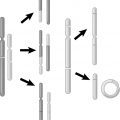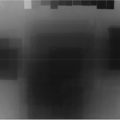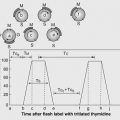18
EFFECTS OF RADIATION ON HEREDITARY DAMAGE, MUTATIONS, AND CHROMOSOME ABERRATIONS
CAMILLE BERRIOCHOA, C. MARC LEYRER, AND ANTHONY MASTROIANNI
Question 1
Why might a male who has received 0.20 Gy (20 rad) to the testicles remain fertile for 6 weeks before noting a diminished sperm count?
Question 3
What data exist to prove that male patients are at greater risk of sterility with fractionated radiation therapy (RT) than with single-dose treatment of an equal or greater dose?
Question 1 Why might a male who has received 0.20 Gy (20 rad) to the testicles remain fertile for 6 weeks before noting a diminished sperm count?
Answer 1
Doses as low as 0.15 Gy (15 rad) cause oligospermia (diminished sperm count). Cells that have already undergone spermatogenesis are relatively radioresistant, in contrast to stem cells, which are more sensitive. Therefore, a male may have functional sperm for up to 6 weeks, with fertility waning once mature sperm have died or been expelled.
Hall EJ, Giaccia AJ. Heritable effects of radiation. In: Hall EJ, Giaccia AJ, eds. Radiobiology for the Radiologist. 7th ed. Philadelphia, PA: Lippincott Williams & Wilkins; 2012:159–173.
Question 3 What data exist to prove that male patients are at greater risk of sterility with fractionated radiation therapy (RT) than with single-dose treatment of an equal or greater dose?
Answer 3
Studies on human male prisoner populations performed in the 1970s demonstrated that a single fraction of 6 Gy to the testes caused azoospermia (absence of living spermatozoa). Multiple studies have demonstrated that doses as low as 2.5 to 3 Gy delivered over a 2- to 4-week fractionated regimen can cause permanent azoospermia.
Centola GM, Keller JW, Henzler M, Rubin P. Effect of low-dose testicular irradiation on sperm count and fertility in patients with testicular seminoma. J Androl. 1994;15:608–613.
Hall EJ, Giaccia AJ. Heritable effects of radiation. In: Hall EJ, Giaccia AJ, eds. Radiobiology for the Radiologist. 7th ed. Philadelphia, PA: Lippincott Williams & Wilkins; 2012:159–173.
Sinno-Tellier S, Bouyer J, Ducot B, Geoffroy-Perez B, Spira A, Slama R. Male gonadal dose of ionizing radiation delivered during x-ray examinations and monthly probability of pregnancy: a population-based retrospective study. BMC Public Health. 2006;6:1–12.
Speiser B, Rubin P, Casarett G. Aspermia following lower truncal irradiation in Hodgkin’s disease. Cancer. 1973;32:692–698.
Question 4
What radiation dose delivered to female gonadal structures is necessary to cause permanent sterility?
Question 6
Why are male patients recommended to wait 6 months following chemotherapy or radiation therapy (RT) prior to attempting conception?
Question 4 What radiation dose delivered to female gonadal structures is necessary to cause permanent sterility?
Answer 4
The effect of dose on female sterility depends on the woman’s inherent fertility at that point in her life. The absolute dose necessary to induce permanent sterility in women varies among various sources. Per Hall’s seventh edition, in a prepubertal female, 12 Gy is required to induce sterility, whereas 2 Gy is sufficient in premenopausal patients. Other studies have demonstrated that 4 to 7 Gy in 1 to 4 fractions increased rates of sterility in premenopausal women greater than 40 years of age, whereas fractionated doses of 20 to 30 Gy in prepubertal females were necessary to cause permanent sterility. In summary, while the absolute threshold may vary among various studies, the underlying finding is that lower doses of radiation induce sterility in premenopausal than in prepubertal females. This decrement in dose necessary to cause sterility is directly related to the decline of functional oocytes as a female ages. Females have approximately 2 million oocytes at birth; this number decreases to 300,000 at puberty and declines further with each passing year, thus making female gonadal structures increasingly susceptible to radiation damage due to decreased ovarian reserve.
Hall EJ, Giaccia AJ. Heritable effects of radiation. In: Hall EJ, Giaccia AJ, eds. Radiobiology for the Radiologist. 7th ed. Philadelphia, PA: Lippincott Williams & Wilkins; 2012:159–173.
Ogilvy-Stuart AL, Shalet SM. Effect of radiation on the human reproductive system. Environ Health Perspect. 1993;101(suppl 2):109–116.
Question 6 Why are male patients recommended to wait 6 months following chemotherapy or radiation therapy (RT) prior to attempting conception?
Answer 6
Several studies have demonstrated increased rates of spermatid aneuploidy in the period immediately following treatment for testicular cancer. Animal studies have been designed to quantify structural chromosomal aberrations and aneuploidy in mouse embryos after spermatozoa were exposed to radiation. While the exact duration of continued radiation-induced aneuploidy in the human is debated, the accepted recommendation is that male patients wait approximately 6 months after radiation exposure before attempting conception to allow for two complete cycles of a 3-month process of spermatogenesis and renewal of nonexposed sperm.
De Mas P, Daudin M, Vincent MC, et al. Increased aneuploidy in spermatozoa from testicular tumour patients after chemotherapy with cisplatin, etoposide and bleomycin. Hum Reprod. 2001;16:1204–1208.
Hall EJ, Giaccia AJ. Heritable effects of radiation. In: Hall EJ, Giaccia AJ, eds. Radiobiology for the Radiologist. 7th ed. Philadelphia, PA: Lippincott Williams & Wilkins; 2012:159–173.
Martin RH, Ernst S, Rademaker A, Barclay L, Ko E, Summers N. Chromosomal abnormalities in sperm from testicular cancer patients before and after chemotherapy. Hum Genet. 1997;99:214–218.
Tateno H, Kusakabe H, Kamiguchi Y. Structural chromosomal aberrations, aneuploidy, and mosaicism in early cleavage mouse embryos derived from spermatozoa exposed to gamma-rays. Int J Radiat Biol. 2001;87:320–329.
Question 7
What was the “megamouse project” and how did it help elucidate radiation-induced hereditary effects in mice?
Question 9
What does the International Commission on Radiological Protection (ICRP) propose are the estimated risks of hereditary effects from radiation for the general population versus the population of radiation workers? Why are these numbers different?
Question 7 What was the “megamouse project” and how did it help elucidate radiation-induced hereditary effects in mice?
Answer 7
This project, led by the husband and wife team of William and Liane Russell at Oak Ridge National Laboratory in Tennessee, evaluated the hereditary effects of radiation on approximately 7 million mice. Investigators found that fractionating a total dose resulted in fewer mutations than if the total dose were given in a single fraction. This finding was in contrast to the dose-rate effect observed in drosophila. Investigators also found that increasing the time interval between radiation exposure and conception decreased the mutation rates found within offspring. Investigators proposed that immediate attempts at conception relied on mature spermatids that were unable to undergo post-radiation therapy (RT) repair, thus leading to higher mutation rates, whereas waiting several weeks from exposure to attempted conception likely allowed those spermatids that had been exposed in a primitive state to undergo repair.
Hall EJ, Giaccia AJ. Heritable effects of radiation. In: Hall EJ, Giaccia AJ, eds. Radiobiology for the Radiologist. 7th ed. Philadelphia, PA: Lippincott Williams & Wilkins; 2012:159–173.
Question 9 What does the International Commission on Radiological Protection (ICRP) propose are the estimated risks of hereditary effects from radiation for the general population versus the population of radiation workers? Why are these numbers different?
Answer 9
This number is based on UN Scientific Committee on the Effects of Atomic Radiation (UNSCEAR) calculations, all of which refer to a reproductive population. These values are described in units of Sievert rather than units of gray. The unit Sievert is an SI unit representing the energy absorbed by 1 kg of biological tissue; like Gy, its units are J/kg, but it represents the biological impact of dose. For reference, 1 Gy = 1 Sv. The hereditary risk for the general population is 0.2%/Sv, whereas the risk for the population working in radiation facilities is 0.1%/Sv. These risk rates may initially seem counterintuitive as one might think that the overall risk should be higher for those working in radiation facilities than for those in the general population. To explain this, consider that the total Sieverts to which a radiation worker will be exposed over his or her lifetime is greater than the total for someone in the general population, thereby increasing the absolute risk for those working in radiation facilities. Additionally, radiation workers are not allowed to work in this environment until the age of 18, whereas the general population has no control of their “general risk” and may be exposed for a longer period of time (from age 0 to age 35, an arbitrary age selected to represent the age at which most individuals stop procreating). Therefore, radiation workers’ risk spans about 17 years (from age 18 to 35), whereas the general population’s risk spans about 35 years. Since the time interval is about 50% less for radiation workers, their percent per Sievert is commensurately lower. Of note, the probability of a hereditary disorder in the first generation born to parents exposed to radiation is estimated to be 0.002%/Sv.
Boice JD, Jr., Tawn EJ, Winther JF, et al. Genetic effects of radiotherapy for childhood cancer. Health Phys. 2003;85:65–80.
Hall EJ, Giaccia AJ. Heritable effects of radiation. In: Hall EJ, Giaccia AJ, eds. Radiobiology for the Radiologist. 7th ed. Philadelphia, PA: Lippincott Williams & Wilkins; 2012:159–173.
Stay updated, free articles. Join our Telegram channel

Full access? Get Clinical Tree






